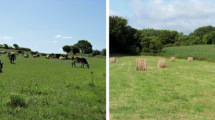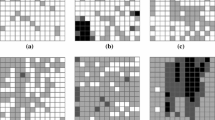Abstract—
One of the important factors in proper rangeland management is determination of grazing capacity which is related to accurate and precise estimation of forage production. As the estimation of forage production is only possible through sampling, so that determination of adequate sample size and suitable sampling method are the main objective of our applied research. The sampling was conducted in five locations in northern grasslands of Iran. In each location, two microplots of 64 m2 were established based on international protocols. By combining the data of five locations, a layout of 640 m2 was simulated in R software. This layout is considered as our statistical population. Primary sample sizes of 20, 25, 30, 35, and 40 were selected and by using different allowable errors with the lowest coefficient of variation, adequate sample sizes of 60 and 120 were obtained. These plot sizes were used to compare the accuracy and precision of methods including random, systematic, random–systematic, two-stage, and stratified sampling. The results showed as the allowable errors are decreasing, the sample sizes are increasing. In general, the mean of stratified sampling is almost equal to the actual mean of the population, indicating its higher accuracy and precision in comparison to other methods. Sample size of 60 and stratified sampling method with 3 to 5 strata were our ultimate selections.







Similar content being viewed by others
REFERENCES
Vermeire, L.T., Ganguli, A.C., and Gillen, R.L., A robust model for estimating standing crop across vegetation types, J. Range Manag., 2002, vol. 55, pp. 494–497.
Flombaum, P. and Sala, O.E., A non–destructive and rapid method to estimate biomass and above ground net primary production, J. Arid Environ., 2007, vol. 69, pp. 352–358.
Holechek, J.L., Pieper, R.D., and Herbel, C.H., Range Management: Principle and Practices, 6th ed., Upper Saddle River, NJ: Prentice Hall, 2011.
Bonham, C.D. Measurement for Terrestrial Vegetation, 2nd ed., New York: Wiley, 2013.
Cochran, W.G. Sampling Techniques. 3rd ed., New York: Wiley, 1977.
Thompson, S.K., Sampling, New York: Wiley, 2002.
Greig–Smith, P. Quantitative Plant Ecology, 3rd ed., London: Butterworth, 1983.
Gauch, H.G., Multivariate Analysis of Community Data, Cambridge: Cambridge Univ. Press, 1982.
Krebs, C.J., Ecological Methodology, 2nd ed., Menlo Park, CA: Benjamin Cummings, 1999.
Avery, T.E. and Burkhart, H. Forest Measurement, 4th ed., New York: McGraw–Hill, 2002.
Bartlett, J. E., Kotrlik, J.W., and Higgins, C.C., Organizational research: Determining appropriate sample size in survey research, Inf. Technol. Learn. Perform. J., 2001, vol. 19, no. 1, pp. 23–31.
Elliott, J.M., Some Methods for the Statistical Analysis of Samples of Benthic Invertebrates, Freshwater Biological Association Sci. Publ. 25, 1983.
Cheryl, D., Raphael, P., and Claude, G., Comparative efficiency and accuracy of variable area transects versus square plots for sampling tree diversity and density, Agrofor. Syst., 2010, vol. 79, pp. 223–236.
Cook, C.W., and Stubbendieck, J. Range Research: Basic Problems and Techniques, Lawrence, KS: Society for Range Management, 1986.
Walther, B.A., and Moore, J.L., The concepts of bias, precision and accuracy, and their use in testing the performance of species richness estimators, with a literature review of estimator performance, Ecography, 2005, vol. 28. pp. 815–829.
Chambers, J.O., and Brown, R.W., Method for Vegetation Sampling and Analysis on Revegetated Mined Lands, Ogden, UT: USDA Forest Service, Intermountain Forest and Range Experiment Station, General Tech. Report INT–151, 1983.
Green, R.H., Sampling Design and Statistical Methods for Environmental Biologists, New York: Wiley, 1979.
Kent, M., Vegetation Description and Data Analysis: A Practical Approach, 2nd ed., New York: Wiley, 2012.
Van der Maarel, E., Vegetation ecology: An overview, in Vegetation Ecology, Van der Maarel, E. and Franklin, J., Eds., Oxford: Blackwell, 2005, pp. 1–3.
Barbour, M. G., Burk, J. H., Pitts, W.D., and Schwartz, F.S., Terrestrial Plant Ecology, 3rd ed., Addison Wesley Longman, 1999.
Huebner, C.D., Detection and monitoring of invasive exotic plants: A comparison of four sampling methods, Northeast. Nat., 2007, vol. 14. pp. 183–206.
Freese, F., Elementary Forest Sampling, Agricultural Handbook no. 232, USDA Forest Service, 1962.
Elzinga, C.L., Salzer, D.W., and Willoughby, J.W., Measuring and Monitoring Plant Populations, BLM Technical Reference no. 1730–1, Denver, CO: Bureau of Land Management, 1998.
Fryxell, J.M., Sinclair, R.E., and Caughley, G., Wildlife Ecology, Conservation, and Management, 3rd ed., Boston, MA: Blackwell, 2014.
Tsutsumi, M., Itano, S., and Shiyomi, M., Number of samples required for estimating herbaceous biomass, J. Rangeland Ecol. Manag., 2007, vol. 60, pp. 447–452.
Fraser, L.H., Jentsch, A., and Sternberg, M., What drives plant species diversiy? A global distributed test of unimodal relationship between herbaceous species richness and plant biomass, J. Veget. Sci. 2014, vol. 25, pp. 1160–1166.
Glantz, S.T., Primer of Biostatistics, 7th ed., New York: McGraw–Hill, 2012.
Steel, R.G.D., Torrie, J.H., and Dickey, D.A. Principles and Procedures of Statistics: A Biometrical Approach, 3rd ed., New York: McGraw–Hill, 1997.
ACKNOWLEDGMENTS
The Research of the Corresponding Author is Supported by a Grant from Ferdowsi University of Mashhad, Iran (N.3/32375).
Author information
Authors and Affiliations
Corresponding author
Ethics declarations
We, as the author of this paper declare that we have no conflict of interest regarding to our paper. All of the collected plants are not endangered species and our clippings were not damaged the plants.
Rights and permissions
About this article
Cite this article
Nafiseh Fakhar Izadi, Naseri, K. & Mesdaghi, M. Adequate Sample Size and Appropriate Sampling Method for Estimating Grassland Production through Simulation. Russ J Ecol 51, 64–71 (2020). https://doi.org/10.1134/S106741362001004X
Received:
Revised:
Accepted:
Published:
Issue Date:
DOI: https://doi.org/10.1134/S106741362001004X




